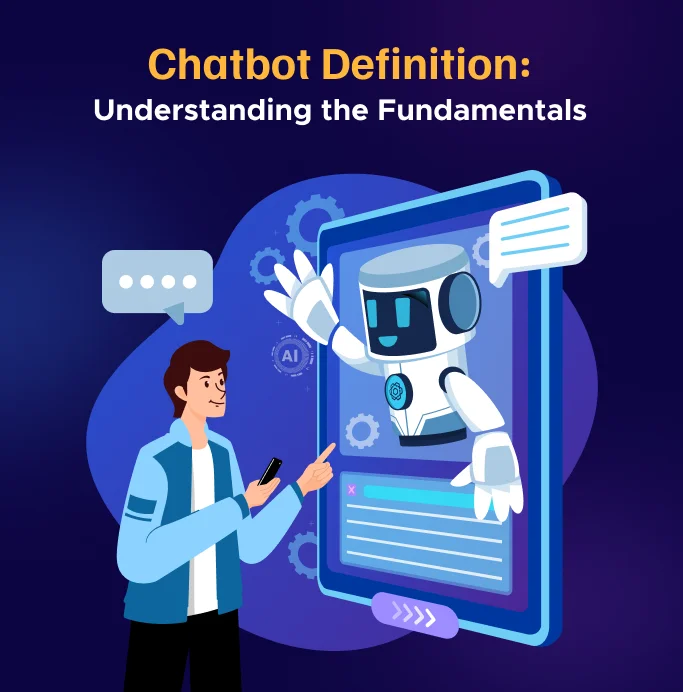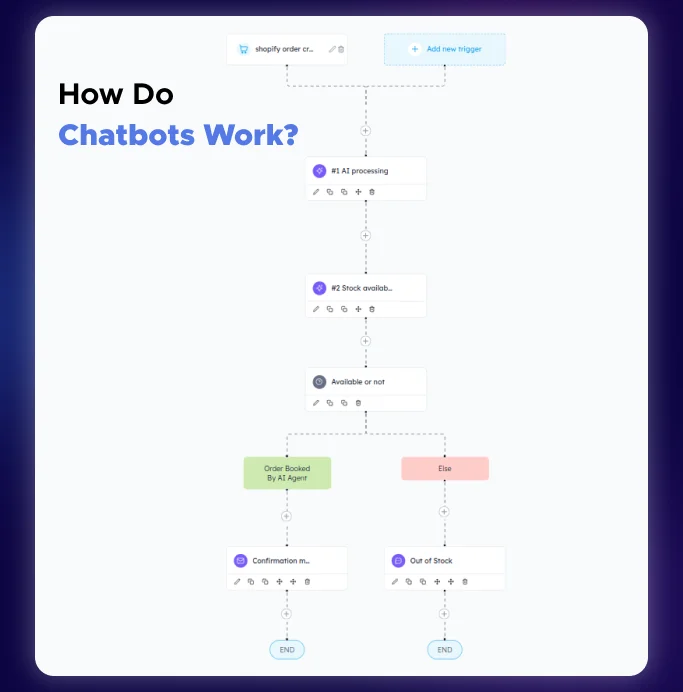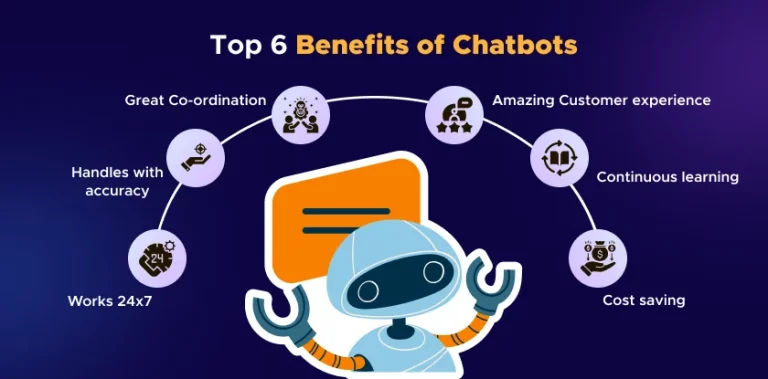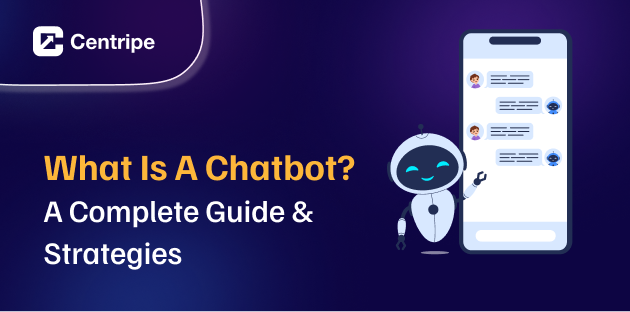A chatbot is a computer program that can have conversations with people through text or voice.
It uses artificial intelligence to understand questions and provide helpful responses.
You can find chatbots on websites, apps, and messaging platforms to get quick answers or assistance.
Think of it as a virtual assistant that’s available 24/7 to chat with you
HERE’s how Chatbot is useful:
Received an important call from a prospect who is ready to buy, but your team isn’t available.
The next day, when you give a call back, they are not interested in buying anymore. Reason: UNAVAILABILITY, not responding when the customer wanted to hear from you.
That is where the customer service chatbot shines. A chatbot is software that chats automatically. It mimics human conversation. This helps businesses connect with customers all day, every day.
Research by Intercom shows that businesses can see a sales increase of up to 67% using chatbots.
They use tech like Natural Language Processing (NLP) and Machine Learning (ML). From answering questions, qualifying leads, and offering customer support without needing humans, they can do almost everything.
Whether you are in marketing, sales, accounts, or any other team, you must learn about chatbot technology. It has become a necessity. The gap between using it well and just having a chatbot is huge.
This guide covers all you need to know. It starts with the basics and goes to advanced strategies that really make a difference.
Chatbot Definition: Understanding the Fundamentals

So what exactly is a chatbot? It communicates with customers through texts or voice interactions. An intermediary between your business and customers.
Modern chatbots use advanced technology.
- NLP lets machines understand human speech, even with mistakes.
- ML: They get smarter over time by using interaction data.
- Conversation Design: These are organised chats that engage users and make them feel appreciated.
- Integration Capabilities: They work with your current tech stack to achieve results.
The Business Context: Why Chatbot Basics Matter Now
When chatbots first came out, there was hesitation. Another tech trend, right?
- They handle 70% of conversations.
- 62% of consumers prefer chatbots over waiting for live agents.
- Businesses can save up to 30% on customer support costs.
- The global chatbot market? It’s projected to hit $10.32 billion by 2025, growing at 24.8% CAGR.
B2B organisations should implement chatbot technology, not just talk about it.
👉 Explore more articles: How to Use E-commerce Chatbot
How Do Chatbots Work?

When you chat with a chatbot, the first step is Input Analysis. When you type or say a question, the chatbot will capture your message.
It uses NLP to figure out what you mean and what you are asking about, even if you don’t use perfect wording.
Then, Processing and Decision Making. The chatbot always checks stored information, like a knowledge base. It also applies any business rules or smart AI models it has learned.
This helps the bot decide what the best answer or next step should be for your specific question.
During the Response Generation stage, the chatbot forms a reply using the information it just processed. It sends this answer back to you in a friendly, conversational way.
It also records the conversation to learn and improve its responses later. Even chatbots get better with practice!
Technical Components That Power Modern Chatbots
Natural Language Understanding (NLU)
It helps chatbots grasp what users say, even if the language isn’t structured. It works by pulling the real meaning from the text. It also spots details like names, dates, and product types. Plus, it understands how urgent the user’s needs are.
The chatbot doesn’t just see words. It understands intent, context, and even when a customer is frustrated or needs quick help.
Dialog Management
This one helps a chatbot remember the conversation. So you don’t have to repeat yourself every time.
It tracks the chat context, manages exchanges well, and knows when a question is too complex. In those cases, it sends the question to a human agent.
This ensures conversations feel natural and efficient, making the user experience much smoother.
Integration Layer
It connects the chatbot to your business’s other digital tools and databases. This information can be easily pulled out from CRM systems. You can access product databases and updated customer records.
This connectivity helps the chatbot give accurate answers and process requests. It also keeps your systems updated without any manual effort.
Types of Chatbots: Choosing the Right Solution
It’s better to understand why you need different types of chatbots. Each one is created with a unique purpose.
Chatbot Comparison Table
| Chatbot Type | Best For | Key Features | Limitations | Cost Range |
|---|---|---|---|---|
| Menu-Based | Simple FAQs, order tracking | Decision tree logic, button-based navigation | Limited to predefined options, not suitable for complex queries | $20-$200/month |
| Rule-Based | Repetitive queries, basic support | Predefined scripts, keyword detection | Struggles with unexpected queries, lacks learning ability | $50-$500/month |
| AI-Powered | Complex service, personalization | Natural language understanding, self-learning | Requires large data sets, higher maintenance | $500-$5,000/month |
| Hybrid | Balanced automation, multi-channel support | Combines rule-based and AI, flexible task handling | Complex integration, higher cost for maintenance | $1,000-$10,000/month |
| AIAgents | Enterprise automation, advanced workflows | Autonomous task completion, deep integration | High initial investment, ongoing training needed | $5,000+/month |
1. Menu-based Chatbots
This kind of helps users by offering specific menus. Giving a wide range of options, so one can select instead of typing text.
Best for: Quick answers, repetitive tasks, and structured navigation. This includes FAQs, appointment bookings, and service information.
Limitations: Not good for complex queries
Real example: A hotel chatbot might present users with a menu like:
- “Press 1 for room availability.”
- “Press 2 for amenities information.”
- “Press 3 to make a booking.”
2. Rule-Based Chatbots
They follow simple rules, like “if you say this, then I do that.”
Best for: Common questions, easy problems, and step-by-step help.
Limitations: They can’t handle any new queries, something not in the books.
Real example: A bot that helps with passwords:
- You say, “I can’t remember my password.”
- Bot says: “No problem! What’s your email?”
- You tell the bot your email.
- Bot says: “Done! Check your email for a reset link. Need help with anything else?”
3. AI-Powered Chatbots
They use machine learning and NLP to grasp context and intent.
Best for: Handling complex customer service, giving personalised recommendations, and enabling dynamic conversations.
Advantages: They improve by learning from interactions.
Real example: An AI chatbot for product recommendations:
- User: “I need something for my dry skin that won’t break me out.”
- Bot: “I see you’re looking for a moisturizer for dry, acne-prone skin. Based on your concerns, I recommend our Hydrating Gel Cream. It’s non-comedogenic and specifically formulated for your skin type. Would you like to know more about its ingredients?”
- See the difference? It’s not just matching keywords, it’s understanding the actual need.
4. Hybrid Chatbots
They mix rule-based logic with AI.
Here’s a simpler version:
Best for: Companies that want fast help and smart answers.
Benefits: You get both easy and smart features together. You have control where needed and intelligence where it matters. I’ve seen these succeed for companies moving from basic to advanced automation.
5. AI Agents
Autonomous systems that can complete complex tasks independently.
Best for: Enterprise-level customer service, multi-step processes
Key features: Self-learning, proactive engagement, cross-platform operation
Key Benefits: Why Your Business Needs Chatbot Technology?

The psychology behind chatbot adoption reveals fascinating patterns in customer behavior that most businesses overlook.
When customers interact with a well-designed chatbot, they often experience what researchers call “digital empathy” – a sense of being understood despite knowing they’re communicating with software.
This phenomenon occurs because effective chatbots mirror human conversation patterns, including acknowledgment phrases, contextual memory, and appropriate response timing.
The key lies in creating what I call “conversational authenticity” – where the bot’s responses feel genuinely helpful rather than robotic. Companies that master this balance see 40% higher engagement rates because customers feel comfortable expressing their needs without the social pressure of human judgment.
1. Always available without getting tired
Chatbots work 24/7. This means your business never stops serving customers. The chatbot is ready to help. It works whether someone visits your website at 2 AM on a Saturday or during holidays when your staff is off.
Being constantly available allows businesses to assist customers in different time zones all over the world.
2. Handling Busy Times Without Breaking Down
When your business gets busy, like during Black Friday or a product launch, chatbots can handle the extra work easily. They step in when things go viral on social media, too.
They can speak to thousands of customers at once and ensure good service for every customer.
This makes you feel relaxed as you don’t have to hire temporary staff during busy times. Every customer receives the same quality of help.
Let’s take an example of Domino’s Pizza, which uses simple chatbots to help customers order pizza easily. It lets them pick from menus for size, toppings, and delivery options.
This system works great. Now, over 65% of orders come through digital channels. Also, customer satisfaction has risen by 25%.
Simple, menu-based chatbots can make ordering easier and keep customers happy.
3. Finding the Right Customers and Connecting Them to the Right People
For sales teams, the sales chatbot works like a very smart assistant. They can ask potential customers questions to see if they want to buy and what they need.
Instead of random transfers, the chatbot links customers directly to the salesperson who understands their needs best.
The chatbot gathers key information before handing the customer over. This way, the salesperson can assist right away.
4. Making Each Customer Feel Special, Even With Lots of Customers
Modern chatbots can remember things about each customer and provide personalized experiences. They recall what customers bought, what they’ve asked about, and their preferred way to communicate.
This means every customer receives suggestions and answers that feel personal. This helps in building your brand name and recognition.
Simply put, a chatbot becomes a ‘personal shopping assistant’ that never forgets the preferences of customers.
5. Learning About Your Customers Automatically
Every chat with a chatbot reveals insights about your customers. The chatbot automatically gathers info on common customer problems, their questions, product interests, and satisfaction with your service.
It’s like getting free market research from every customer chat. This helps you see what your customers truly want and need.
6. Saving Money in Ways That Make Financial Sense
Using chatbots helps businesses save money in several clear ways. They cut down the support requests for human staff. This means you need fewer customer service reps.
They also cut training costs. The chatbot answers common questions, which saves on training staff.
Chatbots attract new customers at a lower cost. They also make fewer mistakes than humans when entering data or processing information.
This mix of savings makes chatbots appealing to business owners and financial managers. They want to boost efficiency and keep costs in check.
Financial Impact: IBM saved 12,000 support hours over 18 months with AI chatbots for internal IT support. (Source: https://www.ibm.com/case-studies)
The benefits of implementing chatbot technology go way beyond simple automation. They change how businesses work, grow, and connect with customers. They also cut costs a lot.
Common Use Cases Across Industries
Sales Development and Lead Generation
Chatbots easily find and connect with potential customers. They begin a chat, converse in a progressive way, and check if they might want to buy something. Even let you know if someone is serious about buying by asking the right questions.
Also, schedule a meeting between potential customers and the sales team. Plus, it ensures that those wanting product demonstrations are qualified buyers.
Note: As per B2brocket, companies see a 45% jump in leads.
Helping Customers When They Need Support
Chatbots take care of many routine customer service tasks. This allows human staff to focus on more complicated issues.
They can answer basic questions. They help customers update account information. They also tell people where their orders are and provide guides to fix simple tech issues.
Note: Chatbots can handle up to 80% of routine tasks and customer inquiries.
Making Marketing Work Better
Chatbots help marketing teams in several useful ways. Like, someone can easily sign up for events, and be reminded too. Also, they suggest content based on the past interests of customers.
Chatbots help people complete surveys and give feedback. They make it feel like a chat instead of a dull form.
Taking Care of Existing Customers
The chatbot can see when a customer could use extra products or services. It suggests these upgrades at just the right moment.
They can make reports that show customers how they use a service. This helps customers find new features that might be useful.
This kind of personal attention helps customers get more value from what they’ve already bought and keeps them as loyal customers.
43% of CMOs and executives around the world expect to use chatbots for marketing, often in the next 2–3 years. This shows a fast adoption at the strategic level. (Source: https://botpress.com/blog/key-chatbot-statistics)
How Different Industries Use Chatbots?
Online Shopping Stores
Let’s say someone is unsure about what product to buy, then the chatbot will ask questions, build a profile for itself, and recommend the right items.
What if the customer forgot the items in the cart? Well, the chatbot will send a reminder. Even offer a discount as per the guidelines, to encourage them to finish the purchase.
Taking an example of a clothing store. It helps customers find the right size and suggest outfits that go well together, i.e., cross-selling. And even keeps them updated on where their orders are, when, and at what time they will arrive.
Hospitals and Healthcare
Healthcare Chatbot helps patients to book doctor appointments without any need to call and wait.
If someone is feeling unwell, they will ask questions about their symptoms. And even suggest seeing a doctor, but note that it doesn’t replace medical advice.
It even sends reminders of taking regular medications, ensuring they don’t forget the pills. Also, checks if insurance will cover certain treatment or procedures.
Now, this saves you money, because you don’t need an agent for routine tasks.
Banks and Financial Companies
Any money-related queries are solved by chatbots. Customers can easily see their account balance without calling or visiting the bank.
It sends alerts for unusual spending that could be fraud, hence protecting the customer’s money.
Let’s say a person applied for a loan, then the chatbot will share updates on approval status and what the next steps are.
This makes banking easier and helps customers feel safer about their money.
Hotels, Airlines, and Travel Companies
Travelling becomes smooth with chatbots. A traveller who wants to change a hotel reservation or flight can do it smoothly now, thanks to advanced technology. They won’t need to talk to a person.
To make the experience more memorable, it suggests good restaurants in the new city, fun attractions, or activities that fit their interests.
For hotels, chatbots can help guests check in faster and answer questions about hotel services.
They also manage loyalty programs. This helps frequent travellers learn about special offers and how to use their points.
How to build your Chatbot Strategy? Implementation
| Phase | Main Focus | Tasks |
|---|---|---|
| Weeks 1–2 | Define Clear Objectives |
|
| Audit Current Processes |
|
|
| Weeks 3–4 | Platform Selection |
|
| Weeks 5–8 | Design & Development |
|
| Technical Implementation |
|
|
| Weeks 9–10 | Testing & Optimization | Testing:
|
| Optimization Metrics |
|
|
| Launch & Scale |
|
|
| Scaling Considerations |
|
Note: The usual timeline for initial deployment is 12 weeks, followed by ongoing optimisation.
Challenges and Solutions
1. The Problem: Complex questions or industry-specific terms
The Solution: Train the chatbots with examples from your industry. It helps them learn the right words and phrases.
It should always have backup plans. For instance, it can ask the person to explain something in a different way or provide simple menu options to choose from.
2. The Problem: Losing track of the conversation
The Solution: Set up your system that helps the chatbot remember the whole conversation from start to finish.
Advanced chatbot programs can track many topics and remember key details during a long chat.
When it passes a user to a human agent, a quick summary of the conversation is provided to them.
3. The Problem: Time-consuming to work with current systems
The Solution: Use chatbots that easily integrate with other tools, such as databases and email. This will create smooth connections.
Start by linking one or two apps, and then move to others. In the meantime, your bots will be trained enough to understand the systems.
4. The Problem: Hesitant to use chatbots and new technology
The Solution: You should be clear about what a chatbot can and can’t do. A ‘hybrid-mode’ will be beneficial.
It makes it easier for customers to switch from chatbot to human agent, removes frustration, and builds trust.
Companies should introduce new chatbot features slowly. This way, customers can get comfortable with them instead of being overwhelmed.
5. The Problem: Security and Private Risks
The Solution: Companies should emphasize having strong encryption, so that customer data is safe.
Routine security check-ups should be implemented to find and fix weaknesses.
Clear privacy policies explain how we use customer information. Getting permission before collecting data builds trust and keeps us compliant with the law.
Future of Chatbots: AI Agents and Beyond – Emerging Trends
1. Smart AI Helpers That Work on Their Own
Future chatbots will manage complex tasks with multiple steps. They won’t need constant human guidance.
They’ll automatically learn from every interaction. This helps them improve at their job over time, without needing to be reprogrammed.
These smart assistants will notice how customers behave and reach out at just the right moment to offer help or suggestions.
2. Understanding How People Feel
Chatbots will know if someone is happy, upset, etc., based on their words and tone. Amazing, isn’t it? It’s called ‘sentiment analysis’.
It will even change the tone and approach based on the customer’s mood, making the conversation more natural, caring, and personalized.
When a situation is too delicate for a bot, it will immediately connect the customer with a real person.
The convergence of chatbots with Internet of Things (IoT) devices is creating unprecedented opportunities for predictive customer service.
Imagine a scenario where your smart refrigerator detects low milk levels and automatically initiates a conversation through your company’s chatbot to suggest a grocery delivery, or when a connected car’s maintenance system triggers a chatbot to schedule service appointments before problems occur.
This “ambient intelligence” approach transforms chatbots from reactive tools into proactive business partners. Early adopters are already experimenting with chatbots that analyze environmental data, user location, and behavioral patterns to deliver contextually perfect interactions. The businesses that embrace this shift will create seamless customer experiences that feel almost magical in their timing and relevance.
3. Using Pictures, Videos, and Gestures
Advanced chatbots will “see” and recognise objects in photos. This will help customers identify products or solve problems visually.
They will use augmented reality to display virtual demos or instructions on your phone or computer screen.
Some chatbots will look like real digital characters. They can hold video conversations with customers.
4. Helping Before You Even Ask
These smart systems will observe how customers interact with websites or apps. They can foresee potential problems before they occur.
Chatbots will learn what you like. Then, they will suggest products, services, or information that you may find helpful.
Also, check in with customers at the right times. This ensures everything is working well and lets you offer help before they ask.
5. Connecting with Smart Home and Wearable Devices
Future chatbots will connect through voice assistants at home. This means you can get customer support just by talking to your smart speaker.
They will link with fitness trackers and smartwatches. This will offer personalised health tips and service reminders.
Getting Your Business Ready for Modern Chatbots
Start with the basics. Organize every day, so it is easy to find. Setting up clear rules on how to use AI. Teach your staff to work on these tools.
Use AI fairly. This stops bias and keeps things responsible. Choose systems that can grow with your company. Use tools that are easy to integrate.
Chatbots help customers reach you through a website, app, or social media. So, it increases your customer base.
👉 Want to learn more? Check out this related blog:
Chatbot Analytics: Essential Performance Metrics Guide
In Short
Chatbots answer questions based on specific sets of data. They have revolutionized the way companies talk to customers, and it has always been beneficial.
Business runs better because customers are happier. They don’t have to wait in a long queue of calls, and they can even solve tough problems.
By 2027, chatbots will become a key player for a quarter of companies. They will help customers, guide them till they buy, and even provide after-sales services.
If you plan well and pick the right tools, your business can get ahead with this technology.
